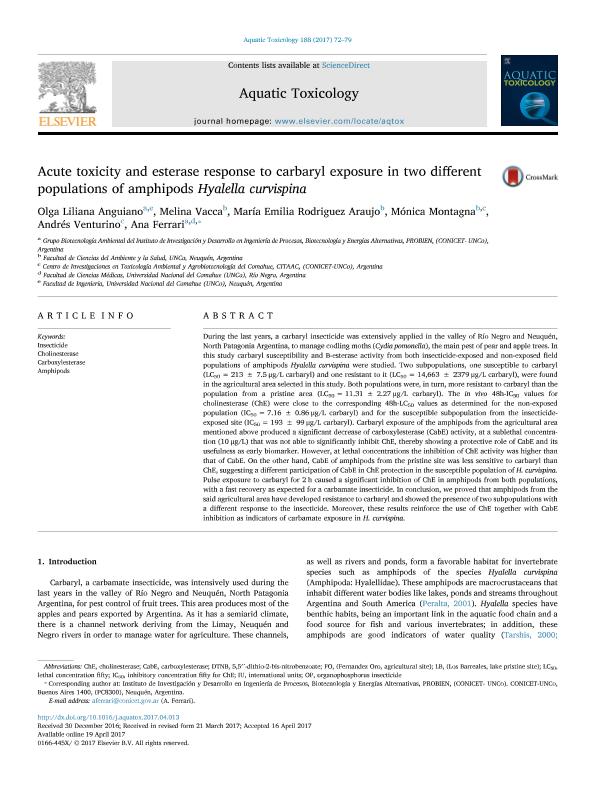Mostrar el registro sencillo del ítem
dc.contributor.author
Anguiano, Olga Liliana

dc.contributor.author
Vacca, Melina
dc.contributor.author
Rodriguez Araujo, María Emilia

dc.contributor.author
Montagna, Mónica
dc.contributor.author
Venturino, Andres

dc.contributor.author
Ferrari, Ana

dc.date.available
2018-08-31T18:43:42Z
dc.date.issued
2017-07
dc.identifier.citation
Anguiano, Olga Liliana; Vacca, Melina; Rodriguez Araujo, María Emilia; Montagna, Mónica; Venturino, Andres; et al.; Acute toxicity and esterase response to carbaryl exposure in two different populations of amphipods Hyalella curvispina; Elsevier Science; Aquatic Toxicology; 188; 7-2017; 72-79
dc.identifier.issn
0166-445X
dc.identifier.uri
http://hdl.handle.net/11336/57925
dc.description.abstract
During the last years, a carbaryl insecticide was extensively applied in the valley of Río Negro and Neuquén, North Patagonia Argentina, to manage codling moths (Cydia pomonella), the main pest of pear and apple trees. In this study carbaryl susceptibility and B-esterase activity from both insecticide-exposed and non-exposed field populations of amphipods Hyalella curvispina were studied. Two subpopulations, one susceptible to carbaryl (LC50 = 213 ± 7.5 μg/L carbaryl) and one resistant to it (LC50 = 14,663 ± 2379 μg/L carbaryl), were found in the agricultural area selected in this study. Both populations were, in turn, more resistant to carbaryl than the population from a pristine area (LC50 = 11.31 ± 2.27 μg/L carbaryl). The in vivo 48h-IC50 values for cholinesterase (ChE) were close to the corresponding 48h-LC50 values as determined for the non-exposed population (IC50 = 7.16 ± 0.86 μg/L carbaryl) and for the susceptible subpopulation from the insecticide-exposed site (IC50 = 193 ± 99 μg/L carbaryl). Carbaryl exposure of the amphipods from the agricultural area mentioned above produced a significant decrease of carboxylesterase (CabE) activity, at a sublethal concentration (10 μg/L) that was not able to significantly inhibit ChE, thereby showing a protective role of CabE and its usefulness as early biomarker. However, at lethal concentrations the inhibition of ChE activity was higher than that of CabE. On the other hand, CabE of amphipods from the pristine site was less sensitive to carbaryl than ChE, suggesting a different participation of CabE in ChE protection in the susceptible population of H. curvispina. Pulse exposure to carbaryl for 2 h caused a significant inhibition of ChE in amphipods from both populations, with a fast recovery as expected for a carbamate insecticide. In conclusion, we proved that amphipods from the said agricultural area have developed resistance to carbaryl and showed the presence of two subpopulations with a different response to the insecticide. Moreover, these results reinforce the use of ChE together with CabE inhibition as indicators of carbamate exposure in H. curvispina.
dc.format
application/pdf
dc.language.iso
eng
dc.publisher
Elsevier Science

dc.rights
info:eu-repo/semantics/openAccess
dc.rights.uri
https://creativecommons.org/licenses/by-nc-sa/2.5/ar/
dc.subject
Amphipods
dc.subject
Carboxylesterase
dc.subject
Cholinesterase
dc.subject
Insecticide
dc.subject.classification
Otras Ciencias Biológicas

dc.subject.classification
Ciencias Biológicas

dc.subject.classification
CIENCIAS NATURALES Y EXACTAS

dc.title
Acute toxicity and esterase response to carbaryl exposure in two different populations of amphipods Hyalella curvispina
dc.type
info:eu-repo/semantics/article
dc.type
info:ar-repo/semantics/artículo
dc.type
info:eu-repo/semantics/publishedVersion
dc.date.updated
2018-08-31T14:07:42Z
dc.journal.volume
188
dc.journal.pagination
72-79
dc.journal.pais
Países Bajos

dc.journal.ciudad
Amsterdam
dc.description.fil
Fil: Anguiano, Olga Liliana. Consejo Nacional de Investigaciones Científicas y Técnicas. Centro Científico Tecnológico Conicet - Patagonia Norte. Instituto de Investigación y Desarrollo en Ingeniería de Procesos, Biotecnología y Energías Alternativas. Universidad Nacional del Comahue. Instituto de Investigación y Desarrollo en Ingeniería de Procesos, Biotecnología y Energías Alternativas; Argentina. Universidad Nacional del Comahue. Facultad de Ingeniería; Argentina
dc.description.fil
Fil: Vacca, Melina. Universidad Nacional del Comahue. Facultad de Ciencias del Ambiente y la Salud; Argentina
dc.description.fil
Fil: Rodriguez Araujo, María Emilia. Consejo Nacional de Investigaciones Científicas y Técnicas; Argentina. Universidad Nacional del Comahue. Facultad de Ciencias del Ambiente y la Salud; Argentina
dc.description.fil
Fil: Montagna, Mónica. Universidad Nacional del Comahue. Facultad de Ciencias del Ambiente y la Salud; Argentina. Centro de Investigaciones en Toxicología Ambiental y Agrobiotecnología del Comahue; Argentina
dc.description.fil
Fil: Venturino, Andres. Consejo Nacional de Investigaciones Científicas y Técnicas; Argentina. Centro de Investigaciones en Toxicología Ambiental y Agrobiotecnología del Comahue; Argentina
dc.description.fil
Fil: Ferrari, Ana. Consejo Nacional de Investigaciones Científicas y Técnicas. Centro Científico Tecnológico Conicet - Patagonia Norte. Instituto de Investigación y Desarrollo en Ingeniería de Procesos, Biotecnología y Energías Alternativas. Universidad Nacional del Comahue. Instituto de Investigación y Desarrollo en Ingeniería de Procesos, Biotecnología y Energías Alternativas; Argentina
dc.journal.title
Aquatic Toxicology

dc.relation.alternativeid
info:eu-repo/semantics/altIdentifier/doi/https://dx.doi.org/10.1016/j.aquatox.2017.04.013
dc.relation.alternativeid
info:eu-repo/semantics/altIdentifier/url/https://www.sciencedirect.com/science/article/pii/S0166445X17301157
Archivos asociados
